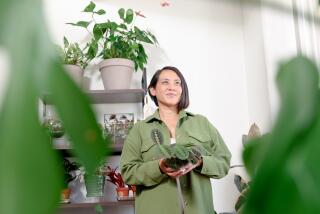Pick your color: Hoya, a succulent in many shades
In the world of succulents, the hundreds of species and cultivars of the hoya genus stand out. They are in the milkweed family, second only to orchids in the diversity of their flower forms and shapes.
Lowland tropicals, hoyas are native to Southeast Asia, densely vining beneath the canopy in the rain forests of New Guinea. Cultivated by enthusiasts for hundreds of years, some of the most exotic hoyas come from the wilds of the Philippines. And yet you will find avid hoya collectors as far off as Sweden.
Echo Park gardener Mary Steffens says she adores hoyas because they are âsurreal.â
âEach type has a different flower,â she says. âI donât know what the flower will look like for some of them.â
She gestures at a cluster of tiny, waxy white blooms, shiny like porcelain, some sporting a single droplet of nectar. The plant hangs in the corner of her greenhouse, where the air is humid and the light bright but diffused.
She has other hoya plants outside, including Hoya carnosa (a variety called Compacta), also known as Hindu rope, but none is in strong sun. They are able to take a few hours of direct morning sun, but they thrive in dappled light or bright indoors locations.
The bouquet and texture of the flowers are worth the wait. The star-shaped flowers come in a rainbow: pink, yellow, orange, burgundy, near-black, white. The leaves may be furry or fleshy, shiny or matte, heart-shaped or oval, large as a plate or small as a penny.
Hoyas are tree climbers that like fast-draining, almost soilless conditions. In the wild, hoyas can stretch 100 feet up to the canopy.
âThey donât need much to grow in,â says John Trager, curator of the desert collection at the Huntington Botanical Gardens in San Marino. âThe roots serve as anchoring as much for nutrition.â
The biggest pests are the mealybugs that thrive in humid greenhouse environments. Rather than flush the bugs with water, Trager suggests taking the potted plant outside and blasting the sticky, cottony residue of the bugs with compressed air.
A hidden benefit if you can keep the plant happy indoors: Hoya carnosa is one of five âsuper ornamentalsâ that remove volatile organic compounds such as benzene and toulene from indoor air, according to a 2009 University of Georgia study.
You can find hoya at Sunset Nursery and most places specializing in succulents, such as Dream Garden, 6751 Sunset Blvd., Los Angeles, (323) 465â0161. The Huntington will probably have hoya for sale at its annual Succulent Symposium on Aug. 31. Another good source: Rainbow Gardens nursery in Vista.
Once youâve got your hoya, it should be planted in a light mix, half perlite or vermiculite, and half potting soil.
Hoya can be easily propagated by putting a section of vine with at least two internodes -- the cut end dusted with growth hormone -- inside a plastic zipper bag with some moist growing medium, like sphagnum moss. Be patient; it could take weeks.
The plants are great for hanging baskets. Wherever you plant it, check for mealybugs regularly and donât skimp on the water. Itâs almost impossible to overwater a properly planted hoya.
Another tip: After the flowers drop, donât deadhead a hoya. Leave the spent flowers. The spurs where the flowers emerged will get a new flush the next year.
The Global Garden is our series looking at multicultural L.A. through the lens of its landscapes. It appears here on Tuesdays.
ALSO:
Thornless blackberries for summer
JOIN US:
@latimeshome | facebook.com/latimesgarden | facebook.com/latimeshome






